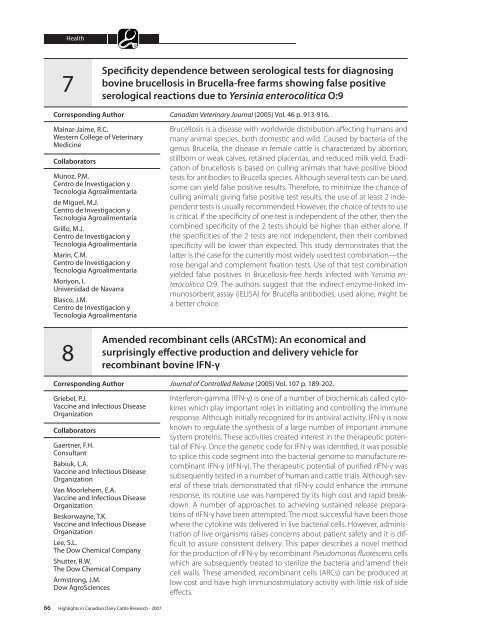A52-75-2007E.pdf - AgroMedia International Inc
A52-75-2007E.pdf - AgroMedia International Inc
A52-75-2007E.pdf - AgroMedia International Inc
Create successful ePaper yourself
Turn your PDF publications into a flip-book with our unique Google optimized e-Paper software.
Health7Specificity dependence between serological tests for diagnosingbovine brucellosis in Brucella-free farms showing false positiveserological reactions due to Yersinia enterocolitica O:9Corresponding AuthorMainar-Jaime, R.C.Western College of VeterinaryMedicineCollaboratorsMunoz, P.M.Centro de Investigacion yTecnologia Agroalimentariade Miguel, M.J.Centro de Investigacion yTecnologia AgroalimentariaGrillo, M.J.Centro de Investigacion yTecnologia AgroalimentariaMarin, C.M.Centro de Investigacion yTecnologia AgroalimentariaMoriyon, I.Universidad de NavarraBlasco, J.M.Centro de Investigacion yTecnologia AgroalimentariaCanadian Veterinary Journal (2005) Vol. 46 p. 913-916.Brucellosis is a disease with worldwide distribution affecting humans andmany animal species, both domestic and wild. Caused by bacteria of thegenus Brucella, the disease in female cattle is characterized by abortion,stillborn or weak calves, retained placentas, and reduced milk yield. Eradicationof brucellosis is based on culling animals that have positive bloodtests for antibodies to Brucella species. Although several tests can be used,some can yield false positive results. Therefore, to minimize the chance ofculling animals giving false positive test results, the use of at least 2 independenttests is usually recommended. However, the choice of tests to useis critical. If the specificity of one test is independent of the other, then thecombined specificity of the 2 tests should be higher than either alone. Ifthe specificities of the 2 tests are not independent, then their combinedspecificity will be lower than expected. This study demonstrates that thelatter is the case for the currently most widely used test combination—therose bengal and complement fixation tests. Use of that test combinationyielded false positives in Brucellosis-free herds infected with Yersinia enterocoliticaO:9. The authors suggest that the indirect enzyme-linked immunosorbentassay (iELISA) for Brucella antibodies, used alone, might bea better choice.8Amended recombinant cells (ARCsTM): An economical andsurprisingly effective production and delivery vehicle forrecombinant bovine IFN-γCorresponding AuthorGriebel, P.J.Vaccine and Infectious DiseaseOrganizationCollaboratorsGaertner, F.H.ConsultantBabiuk, L.A.Vaccine and Infectious DiseaseOrganizationVan Moorlehem, E.A.Vaccine and Infectious DiseaseOrganizationBeskorwayne, T.K.Vaccine and Infectious DiseaseOrganizationLee, S.L.The Dow Chemical CompanyShutter, R.W.The Dow Chemical CompanyArmstrong, J.M.Dow AgroSciencesJournal of Controlled Release (2005) Vol. 107 p. 189-202.Interferon-gamma (IFN-γ) is one of a number of biochemicals called cytokineswhich play important roles in initiating and controlling the immuneresponse. Although initially recognized for its antiviral activity, IFN-γ is nowknown to regulate the synthesis of a large number of important immunesystem proteins. These activities created interest in the therapeutic potentialof IFN-γ. Once the genetic code for IFN-γ was identified, it was possibleto splice this code segment into the bacterial genome to manufacture recombinantIFN-γ (rIFN-γ). The therapeutic potential of purified rIFN-γ wassubsequently tested in a number of human and cattle trials. Although severalof these trials demonstrated that rIFN-γ could enhance the immuneresponse, its routine use was hampered by its high cost and rapid breakdown.A number of approaches to achieving sustained release preparationsof rIFN-γ have been attempted. The most successful have been thosewhere the cytokine was delivered in live bacterial cells. However, administrationof live organisms raises concerns about patient safety and it is difficultto assure consistent delivery. This paper describes a novel methodfor the production of rIFN-γ by recombinant Pseudomonas fluorescens cellswhich are subsequently treated to sterilize the bacteria and ‘amend’ theircell walls. These amended, recombinant cells (ARCs) can be produced atlow cost and have high immunostimulatory activity with little risk of sideeffects.66 Highlights in Canadian Dairy Cattle Research - 2007





